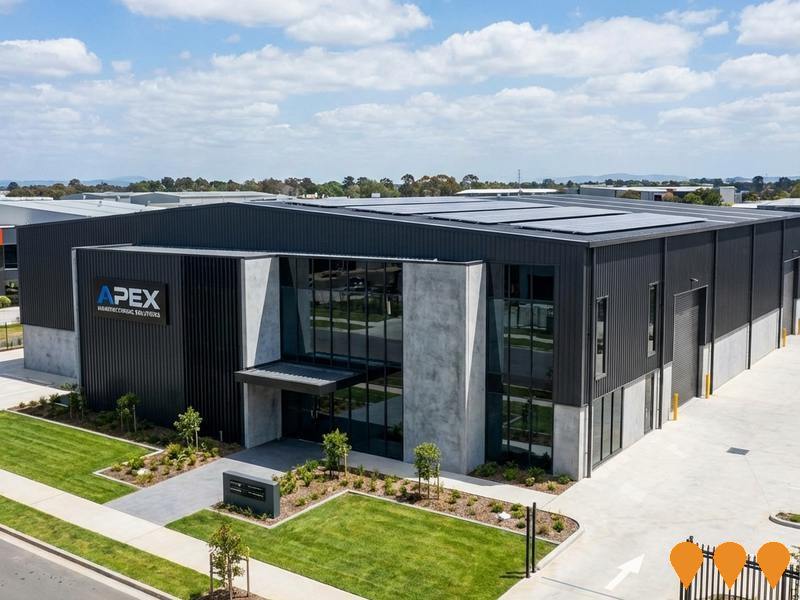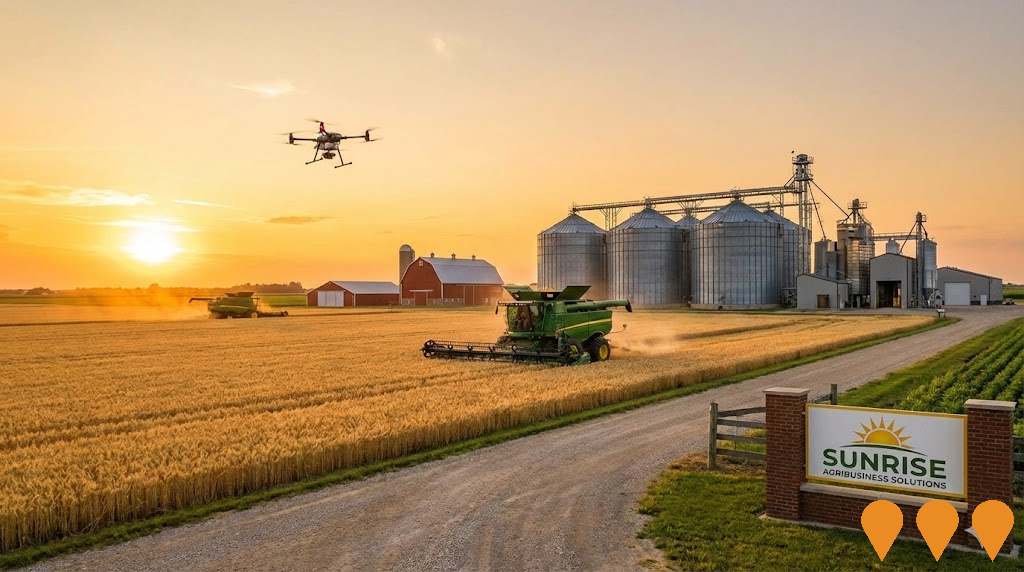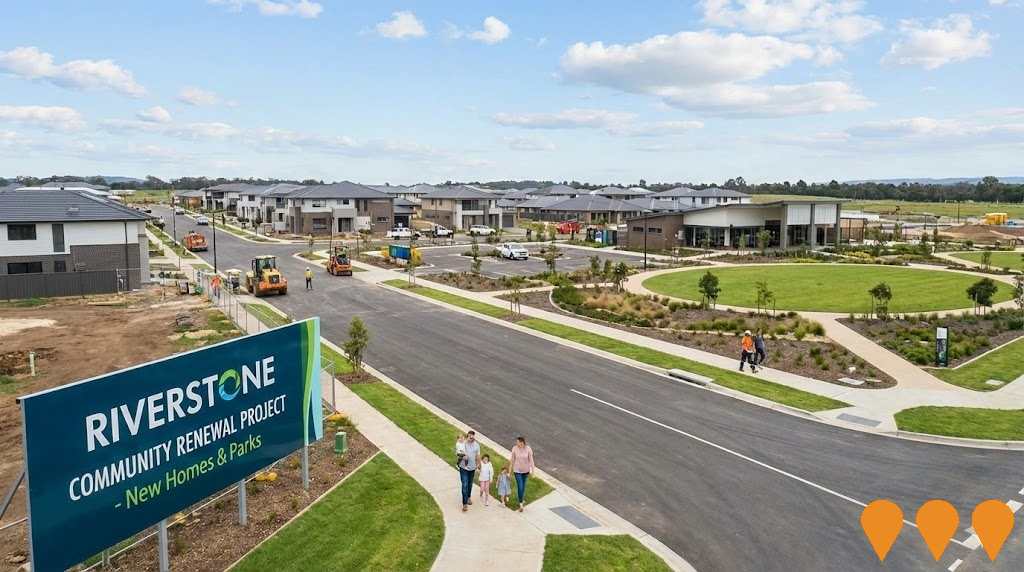Chart Color Schemes
est. as @ -- *
ABS ERP | -- people | --
2021 Census | -- people
Sales Activity
Curious about local property values? Filter the chart to assess the volume and appreciation (including resales) trends and regional comparisons, or scroll to the map below view this information at an individual property level.
Find a Recent Sale
Sales Detail
Population
An assessment of population growth drivers in Kingaroy reveals an overall ranking slightly below national averages considering recent, and medium term trends
Kingaroy's population was approximately 10,545 people as of August 2021. By August 2025, the population had increased to around 11,018, a growth of 473 people (4.5%). This increase is inferred from the estimated resident population of 11,009 in June 2024 and an additional 72 validated new addresses since the Census date. The population density was approximately 157 persons per square kilometer. Kingaroy's growth rate of 4.5% since the census is within 1.5 percentage points of the SA3 area's growth rate of 6.0%. Overseas migration contributed approximately 44.8% of overall population gains during recent periods, with all drivers including natural growth and interstate migration being positive factors.
AreaSearch uses ABS/Geoscience Australia projections for each SA2 area released in 2024 with a base year of 2022. For areas not covered by this data and years post-2032, Queensland State Government's SA2 area projections released in 2023 based on 2021 data are adopted. These state projections do not provide age category splits, so AreaSearch applies proportional growth weightings in line with the ABS Greater Capital Region projections for each age cohort. Future population trends project an above median growth for national regional areas, with Kingaroy expected to grow by 1,539 persons to 2041, reflecting a total increase of 13.9% over the 17 years.
Frequently Asked Questions - Population
Development
Recent residential development output has been above average within Kingaroy when compared nationally
Kingaroy has recorded approximately 28 residential properties granted approval annually. Over the past five financial years, from FY-21 to FY-25, around 140 homes were approved, with a further 23 approved in FY-26 so far. On average, over these five years, about 3.4 new residents arrived per dwelling constructed annually.
This demand significantly outpaces supply, which typically puts upward pressure on prices and increases competition among buyers. The average construction cost value of new homes is around $515,000, in line with regional trends. In the current financial year, approximately $72.9 million in commercial approvals have been registered, indicating robust local business investment. Compared to the rest of Queensland, Kingaroy shows about 75% of the construction activity per person, placing it among the 50th percentile of areas assessed nationally.
This reflects market maturity and suggests possible development constraints. New developments in Kingaroy consist of approximately 91.0% standalone homes and 9.0% attached dwellings, maintaining the area's traditional low density character with a focus on family homes appealing to those seeking space. The location has around 336 people per dwelling approval, indicating a low density market. Looking ahead, Kingaroy is expected to grow by approximately 1,530 residents through to 2041. At current development rates, housing supply may struggle to match population growth, potentially heightening buyer competition and supporting price increases.
Frequently Asked Questions - Development
Infrastructure
Kingaroy has moderate levels of nearby infrastructure activity, ranking in the 43rdth percentile nationally
Changes to local infrastructure significantly influence an area's performance. AreaSearch has identified 14 projects that could impact the area. Notable projects include South Burnett Renewable Energy Hub, Hillview Estate, Kingaroy Solar Farm, and Kingaroy Youth Park Redevelopment: Stage 1. The following list details those most relevant.
Professional plan users can use the search below to filter and access additional projects.
INFRASTRUCTURE SEARCH
 Denotes AI-based impression for illustrative purposes only, not to be taken as definitive under any circumstances. Please follow links and conduct other investigations from the project's source for actual imagery. Developers and project owners wishing us to use original imagery please Contact Us and we will do so.
Denotes AI-based impression for illustrative purposes only, not to be taken as definitive under any circumstances. Please follow links and conduct other investigations from the project's source for actual imagery. Developers and project owners wishing us to use original imagery please Contact Us and we will do so.
Frequently Asked Questions - Infrastructure
Kingaroy Hospital Redevelopment
Redevelopment of Kingaroy Hospital delivering a new two-level clinical services building with around 66 beds. The project expanded emergency, inpatient, maternity, operating theatres, dialysis, chemotherapy, and outpatient services, replacing and refurbishing parts of the old campus. The upgrade increases local care capacity for the South Burnett so fewer patients need to travel to larger centres.

South Burnett Renewable Energy Hub
The South Burnett Renewable Energy Hub is a regional initiative led by the South Burnett Regional Council to establish the area as a key renewable energy center in Queensland. It encompasses multiple projects including the Tarong West Wind Farm, Kingaroy Solar Farm, and South Burnett Battery Energy Storage System (BESS), focusing on solar, wind, and storage to support Queensland's renewable energy goals. The hub is expected to create hundreds of construction and permanent jobs, boost local economy, and increase housing demand in the region.

New Kingaroy Shopping Complex
Multi-million dollar shopping complex in Kingaroy, including two buildings with three large retail display areas and an adjacent car park with spaces for 54 customer vehicles (including two disability parking bays) plus 16 staff parking areas. Rumors suggest it may include a Spotlight store.

Kingaroy Water for Growth
Increase water security for urban use and provide water security for agricultural irrigation through the construction of a new 150ML off-stream storage at Gordonbrook Water Treatment Plant.

Kingaroy Solar Farm
A 53MW solar farm project bringing renewable energy to the area, now operational and in the Operations and Maintenance phase as of June 2025. It comprises solar PV modules, steel racking and piled supports, electrical transformers and inverters, electrical cabling, battery storage, telecommunications equipment, internal access tracks, an electrical operations room, substation, perimeter fencing, and an adequate buffer between sensitive receptors provided by setback and landscape planting.

Kingaroy Youth Park Redevelopment: Stage 1
South Burnett CTC Inc will deliver Stage 1 works at the Kingaroy Youth Park to expand youth and family services. Scope includes a new welcoming reception, community undercover area, chat rooms, amenities, offices, landscaping and car parking. The project is 50/50 funded by the Australian Government Growing Regions Program and CTC (about $3.96m total). Tender awarded to Favier Building Industries; construction scheduled to commence October 2025.
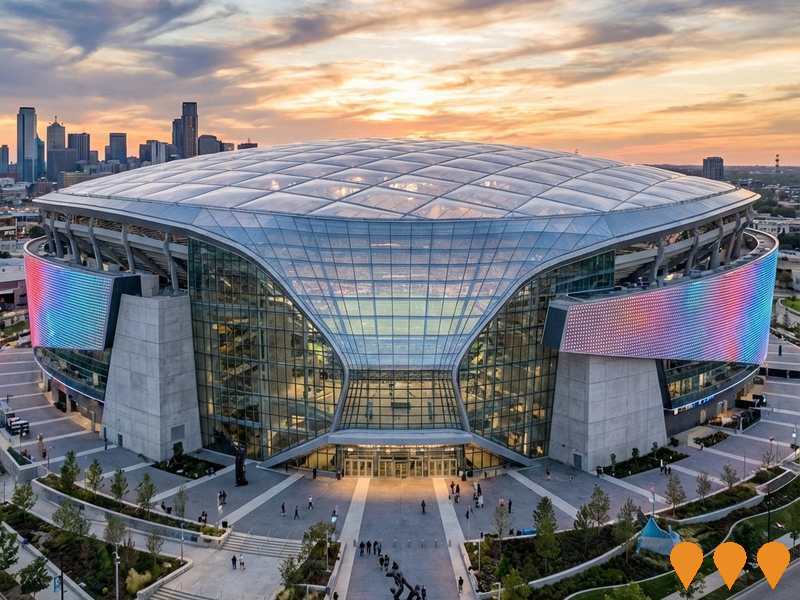
South Burnett Rail Trail Expansion
The highly successful 44 km rail trail connecting Kingaroy to Murgon is part of the larger 89 km Kingaroy to Kilkivan Rail Trail. Recent stakeholder meetings and community advocacy focus on further developments, upgrades, and potential extensions to enhance eco-tourism, user experience, and investment opportunities in the region.
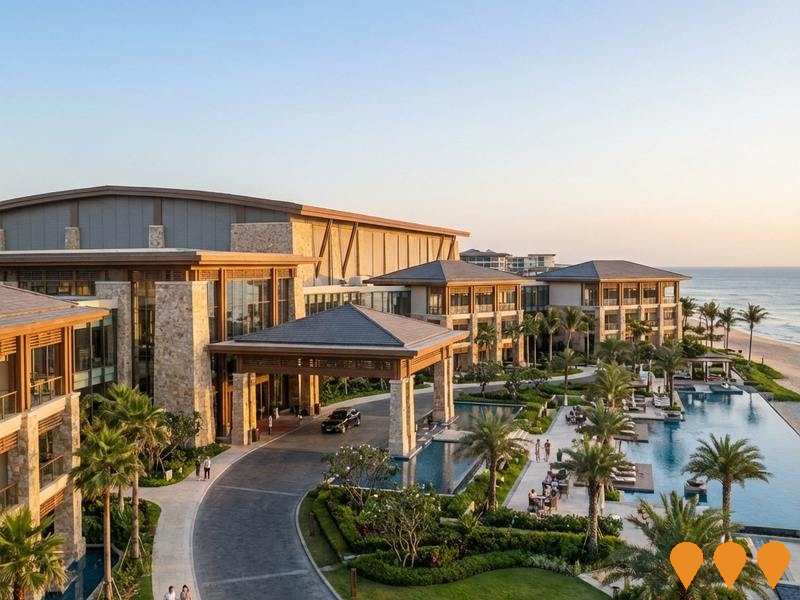
Hillview Estate
Hillview Estate is a quiet residential neighbourhood conveniently located on the outskirts of Kingaroy, with essential amenities like schools, shopping centres, sporting grounds, parks, and recreational facilities nearby. It is in the final stages of development, with Stage 10A sold out and Stage 10B to be available in February 2025.

Employment
Kingaroy has seen below average employment performance when compared to national benchmarks
Kingaroy has a balanced workforce with white and blue collar jobs. The unemployment rate was 5.5% in the past year, with an estimated employment growth of 6.6%.
As of June 2025, 5,536 residents are employed, with an unemployment rate of 1.6% above Rest of Qld's rate of 3.9%, and workforce participation at 55.3%. Key industries include health care & social assistance, manufacturing, and retail trade. Manufacturing is particularly prominent, employing 2.5 times the regional level. However, professional & technical services employ only 2.4% of local workers, below Rest of Qld's 5.1%.
Many residents commute elsewhere for work. In the past year, employment increased by 6.6%, while labour force grew by 7.6%, raising unemployment by 0.9 percentage points. This contrasts with Rest of Qld, where employment rose by 1.8% and unemployment by 0.2%. Jobs and Skills Australia forecasts national employment growth at 6.6% over five years and 13.7% over ten years. Applying these projections to Kingaroy's employment mix suggests local growth of approximately 5.7% over five years and 12.6% over ten years, though this is a simple extrapolation for illustrative purposes only.
Frequently Asked Questions - Employment
Income
The area's income levels rank in the lower 15% nationally based on AreaSearch comparative data
Kingaroy's median income among taxpayers in financial year 2022 was $44,409. The average income stood at $52,756 during the same period. In comparison, Rest of Qld's median and average incomes were $50,780 and $64,844 respectively. By September 2025, estimates based on a 13.99% Wage Price Index growth suggest Kingaroy's median income will be approximately $50,622 and the average income $60,137. According to the 2021 Census, incomes in Kingaroy fall between the 17th and 22nd percentiles nationally for households, families, and individuals. The income analysis shows that the majority of residents, 28.5% or 3,140 people, earn within the $1,500 - $2,999 bracket. After housing costs, 85.8% of income remains, which ranks at the 20th percentile nationally.
Frequently Asked Questions - Income
Housing
Kingaroy is characterized by a predominantly suburban housing profile, with a higher proportion of rental properties than the broader region
Dwelling structure in Kingaroy, as evaluated at the latest Census, comprised 86.4% houses and 13.6% other dwellings. In comparison, Non-Metro Qld had 93.4% houses and 6.6% other dwellings. Home ownership in Kingaroy was 33.7%, with mortgaged dwellings at 28.9% and rented ones at 37.4%. The median monthly mortgage repayment was $1,213, higher than Non-Metro Qld's average of $1,083. Median weekly rent in Kingaroy was $262, compared to Non-Metro Qld's $230. Nationally, Kingaroy's median monthly mortgage repayment was significantly lower at $1,213 than the Australian average of $1,863, and median weekly rent was substantially below the national figure of $375.
Frequently Asked Questions - Housing
Household Composition
Kingaroy features high concentrations of group households and lone person households, with a higher-than-average median household size
Family households constitute 66.0% of all households, including 23.4% couples with children, 27.7% couples without children, and 13.3% single parent families. Non-family households account for the remaining 34.0%, with lone person households at 30.0% and group households making up 4.2% of the total. The median household size is 2.4 people, which is larger than the Rest of Qld average of 2.3.
Frequently Asked Questions - Households
Local Schools & Education
Kingaroy faces educational challenges, with performance metrics placing it in the bottom quartile of areas assessed nationally
The area's university qualification rate is 14.6%, substantially below Australia's average of 30.4%. Bachelor degrees are the most common at 10.8%, followed by postgraduate qualifications (2.2%) and graduate diplomas (1.6%). Trade and technical skills are prominent, with 40.0% of residents aged 15+ holding vocational credentials - advanced diplomas (9.3%) and certificates (30.7%). Educational participation is high at 28.0%, including primary education (11.0%), secondary education (8.8%), and tertiary education (2.3%).
Kingaroy's five schools have a combined enrollment of 2,694 students, with typical Australian school conditions (ICSEA: 954) and balanced educational opportunities. The area functions as an education hub with 24.4 school places per 100 residents, significantly above the regional average of 14.0, attracting students from surrounding communities.
Frequently Asked Questions - Education
Schools Detail
Nearby Services & Amenities
Transport
No public transport data available for this catchment area.
Frequently Asked Questions - Transport
Transport Stops Detail
Health
Health performance in Kingaroy is well below average with prevalence of common health conditions notable across both younger and older age cohorts
Kingaroy faces significant health challenges, as indicated by health data. Both younger and older age groups exhibit high prevalence rates for common health conditions.
Private health cover is low in Kingaroy, at approximately 47% of the total population (around 5,145 people), compared to the national average of 55.3%. Mental health issues and arthritis are the most prevalent medical conditions, affecting 10.6% and 10.4% of residents respectively. About 61.8% of residents claim to be free from medical ailments, slightly higher than the Rest of Qld's figure of 59.4%. Kingaroy has a lower proportion of seniors aged 65 and over, at 20.4% (2,252 people), compared to Rest of Qld's 26.8%. The health outcomes among seniors in Kingaroy are broadly similar to those of the general population.
Frequently Asked Questions - Health
Cultural Diversity
Kingaroy is considerably less culturally diverse than average when assessed alongside AreaSearch's national rankings for language and cultural background related metrics
Kingaroy's cultural diversity was found to be below average, with 88.6% of its population being Australian citizens, 88.5% born in Australia, and 94.5% speaking English only at home. The predominant religion in Kingaroy is Christianity, accounting for 54.8% of the population, compared to 56.4% across the rest of Queensland. In terms of ancestry, the top three represented groups are Australian (30.2%), English (30.0%), and German (8.6%).
Notably, certain ethnic groups have different representations: Australian Aboriginal is overrepresented at 4.3%, compared to 6.0% regionally; New Zealanders make up 0.7% versus 0.5%; and Maori people constitute 0.5% compared to the regional average of 0.3%.
Frequently Asked Questions - Diversity
Age
Kingaroy's population is slightly younger than the national pattern
The median age in Kingaroy is 38 years, which is slightly lower than Rest of Qld's average of 41 but matches Australia's median age of 38. The 25-34 age group constitutes 15.1% of Kingaroy's population, higher than Rest of Qld's percentage. Conversely, the 45-54 cohort makes up only 10.1%. According to post-2021 Census data, the 25-34 age group has increased from 13.4% to 15.1%, while the 5-14 cohort has decreased from 13.5% to 12.3%. By 2041, Kingaroy's population is expected to experience significant demographic changes. Notably, the 25-34 age group will grow by 29%, adding 477 people and reaching a total of 2,137 from its current figure of 1,659. Meanwhile, the 15-24 cohort is projected to decrease by 112 people.
